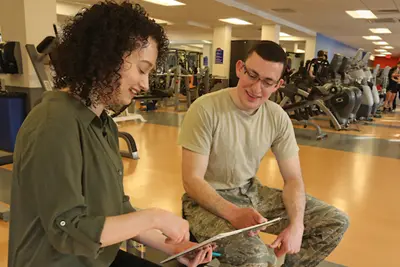Exercise and Fitness Management Option Combines Science, Business and Psychology
 Image by Courtesy
Image by Courtesy
02/26/2021
By Katharine Webster
When transfer student Michael Hines began as an exercise physiology major at UMass Lowell, he had already taken two-plus years of college business classes and worked for several years.
The exercise physiology major was designed to prepare students, through a rigorous science curriculum, to go on for their doctorates in physical therapy or other clinical graduate degrees, such as chiropractic or physician assistant.
Two years ago, the Department of Physical Therapy and Kinesiology renamed the major “exercise science” and split it into two focus areas: the original, clinical option; and a new exercise and fitness management (EFM) option that combines courses in science with business, public health and psychology classes.
Hines, who had played basketball at Framingham State, switched over. He says that the EFM option combines his twin passions: business and sports. Now 32 and a senior, he’s not sure if he wants to go on for his doctorate in physical therapy. But he does know that he wants to run his own athletic training or physical therapy business one day.
“I always had that entrepreneurial spirit. I was selling candy when I was 12 years old, selling sneakers, selling cellphones,” he says. “I want to work with athletes. I also want to work with younger kids, because I was kind of wandering when I was that age, and I want to offer them guidance.”
Hines is the kind of student the EFM option was designed for, says Program Director and Asst. Teaching Prof. Kyle Coffey.
The EFM option, which the Zuckerberg College of Health Sciences developed in close consultation with the Manning School of Business, allows enough business electives for students to complete a business minor. Then, if they want to, they can go on for an MBA, Coffey says.
“The program is growing as we’re saying, ‘Here’s what you can do with it,’ and as the business school is saying, ‘If you’re interested in sports and fitness, do this as an undergrad and then come get an MBA,” he says.
It’s also a good option for students who start off in the clinical option and then find that they want to explore other career possibilities, Coffey says.
“We have the state’s only public physical therapy program. That’s a big draw for students to initially apply to the university,” Coffey says. “And then, along the way, some of them realize they don’t want to be hands-on, but they want to remain in the fitness and wellness sphere, and they can slide into the EFM option.”
 Image by Jordyn Rochon
Image by Jordyn Rochon
EFM is especially exciting for UML’s Division 1 athletes who want to pursue careers in college or professional athletics, he says.
“To do that, you have to understand budgets and management, organizational behavior – all of the things that go into that D1 or pro program, which can be intense,” he says.
Women’s soccer player Gabrielle Weilding, a sophomore, says she chose the EFM option before the end of her first year, when college-based advisor Jennifer Keene-Crouse helped her understand all of the different things she could do with the degree.
“With exercise and fitness management, there are so many options,” she says. “I’ve been an athlete my entire life, so I’ve always wanted to stay in sports. Sports marketing, sports management – there are so many jobs I’d be interested in.”
Coffey believes the clinical option will always be the more popular choice within exercise science. But he expects the EFM option, which now has 35 students enrolled, to continue attracting more undergraduates and applicants. He hopes that soon the department can add a for-credit internship, similar to the clinical experience that students in the clinical option must complete.
Hines has already gotten a head start. With help from Coffey, he got an internship this semester at Athletic Evolution in Woburn, Massachusetts, which has high-level athletic strength and conditioning, physical therapy and general fitness all under one roof.
Hines says he’s already working with the certified strength and conditioning trainers. He will also get to rotate through the business operations and the physical therapy unit, giving him insight into several aspects of the operation.
“It’s exciting,” he says. “They’ve trained some players that have actually made it to the NFL, the NBA, the NHL and Major League Baseball. They currently have football players that are training for the NFL combine, along with many high school athletes who want to go to D1 schools.”
Hines also hopes the internship will help him decide whether he wants to go back to school after he graduates in May and complete the science classes he needs to apply for a doctor of physical therapy degree program.
“I know physical therapy is a very big time and financial commitment, so it’s something I’ve got to be 110 percent sure about,” he says.




